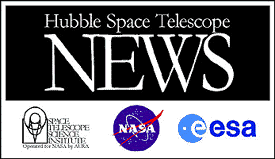 PRESS RELEASE NO.: STScI-PR98-02
PRESS RELEASE NO.: STScI-PR98-02
 PRESS RELEASE NO.: STScI-PR98-02
PRESS RELEASE NO.: STScI-PR98-02
CONTACT:
|
Ray Villard Space Telescope Science Institute, Baltimore, MD (Phone: 410-338-4514)
James Cornell, CfA |
Peter Garnavich, CfA (Phone: 617/495-9245)
|
WASHINGTON, DC -
Peering halfway across the universe to analyze light from exploded stars, which died long before our Sun even existed, NASA's Hubble Space Telescope has allowed astronomers to determine that the expansion of the cosmos has not slowed since the initial impetus of the Big Bang and, thus, should continue to balloon outward indefinitely.
Reporting their preliminary observations today at the winter meeting of the American Astronomical Society, the team, led by Peter Garnavich of the Harvard-Smithsonian Center for Astrophysics (CfA) in Cambridge, MA, concludes there is insufficient matter in the cosmos to provide the gravity necessary to halt its infinite expansion.
If these early conclusions are supported by additional observations, the lack of any significant deceleration since the initial conditions also means the universe could be as much as 15 billion years old. This would clearly establish the universe as truly older than the oldest stars, thus resolving the potential paradox caused by earlier estimates favoring a younger universe.
These results are based on unprecedented distance measurements to supernovae so far away they allow astronomers to determine if the universe was expanding at a faster rate long ago. The most distant supernova seen is approximately halfway back to the Big Bang, and thus existed about 7.7 billion years ago. The two others studied, each exploded approximately 5 billion years ago, or just before our own Solar System formed.
"We cannot make much of a conclusion from the single farthest supernova we've seen", says Garnavich. "But, when we average it with several others, we find, to a 95 percent level of confidence, that the density of matter is insufficient to halt the expansion of the universe".
"In other words, we'd bet $100 against your $5 that the universe isn't bound by matter - dark matter, bright matter, matter that clusters, or matter that's spread out", says co-investigator Robert Kirshner, also of CfA.
Because supernovae are the brightest events in the universe,
they are ideal candidates to use as yardsticks for measuring vast cosmic distances.
The supernovae studied by Hubble, belonging to a class called Type Ia, are considered reliable distance indicators
because there is a direct link between their intrinsic brightness and rate of dimming following their explosions.
Although this class of supernovae has been sought since the 1950s,
astronomers had to wait for Hubble's sharp vision to identify objects far enough away
to provide evidence for the deceleration of the universe.
Because Hubble observations had to be scheduled long in advance, a ground-based search for candidate supernovae was made by the Canada-France-Hawaii Telescope (CFHT) on Mauna Kea, Hawaii. Spectroscopic observations were made at the Keck Observatory, also on Mauna Kea, and at the joint Smithsonian Institution-University of Arizona Multiple Mirror Telescope Observatory (MMTO) on Mt. Hopkins, Arizona, to measure the supernovae's reds hifts, which indicate relative distances from Earth.
Hubble was then used for follow-up observations using discretionary time provided by Space Telescope Science Institute (STScI) director, Robert Williams. Hubble made five observations of each of the three supernovae initially targeted. The observations were separated by about a week, to allow time for the supernovae to dim so astronomers could plot the required light curves.
The search for the "deceleration parameter" - fundamental to estimating the age of the universe and its ultimate fate - has been pursued by cosmologists for nearly a half-century. However, the researchers caution that their findings are preliminary and that a sample of many more supernovae is needed either to yield a value for the density of matter in space to within 10 percent or to refine estimates of the universe's deceleration. They plan to use Hubble's new infrared capabilities to study even more distant supernovae.
For more information and pictures relative to the fundaments of this release, link to Hubble Pinpoints Distant Supernovae (HubbleSite - NewsCenter, January 8, 1998)
![]() The Space Telescope Science Institute is operated by the
Association of Universities for Research in Astronomy, Inc. (AURA),
The Space Telescope Science Institute is operated by the
Association of Universities for Research in Astronomy, Inc. (AURA),
for NASA, under contract with the
Goddard Space Flight Center, Greenbelt, MD.
The Hubble Space Telescope is a project of international cooperation between NASA and the
European Space Agency (ESA).
![]() Updated: January 19 '98
Updated: January 19 '98
Best seen with MS Internet Explorer.
Back: STScI - Background Information
Messages: